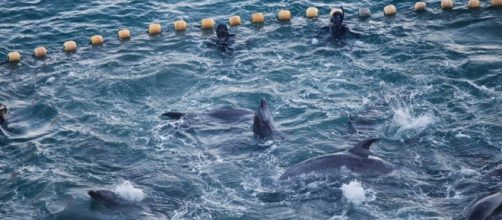On Friday January 20, 2017, a group of fishermen participating in the annual dolphin drive left The Cove in Taiji, Japan. What they found was an amazing super-pod of 300 Bottlenose dolphins. During the five days that followed, the fishermen selected 100 of the youngest and prettiest dolphins from the super-pod so that they could sell them to marine parks and aquariums worldwide.
The annual dolphin drive is often referred to as the Red Cove
Every year between September and March, fishermen from Taiji participate in what is called a dolphin drive. According to the Dolphinproject.net website, the term “dolphin drive” refers to the way in which the fishermen catch dolphins and small sized whales.
The species of dolphin sought after are Bottlenose, Risso’s, Pacific white-sided, Pantropical spotted and Striped. The Short-finned pilot whale is also hunted.
Once a pod is located, the fishermen will surround them while positioning their boats in a V-shaped pattern. They will then herd or “drive” the pod back to the cove. Nets are used to prevent the animals from escaping back to the open sea.
Divers will then inspect the animals. Those deemed worthy are separated from their pod, trained and eventually sold to marine parks and aquariums in the Middle East, China, Russia and Japan. The animals deemed not worth will sometimes be freed but most of the time, they are slaughtered for meat. The waters end up turning red from the blood, hence the term “Red Cove”.
Eye witness accounts show inhumane treatment of the super-pod
The Sea Shepherd’s Cove Guardians are the only group of volunteers who monitor and report on the dolphin drive. Using social media such as Facebook Live and Twitter, the Cove Guardians have managed to document this year’s hunt, including the capture of the super-pod.
Viewing photographs and video taken over the five day ordeal, it is obvious that the dolphins are distressed and hungry. Some of the footage that went viral shows a dolphin vomiting from the stress, a mother dolphin trying to protect her baby from capture by the divers, and a lone dolphin who managed to escape but did not swim too far away from The Cove.
The Cove Guardians also confirmed that in addition to the 100 dolphins taken from the super-pod, four dolphins died while held captive.
However, it is possible that many more dolphins died inside The Cove but the bodies were not visible.
What happened to the dolphins after the selection process
On January 24th, The Cove did not turn red, calming the fears of animal advocates. Instead, the remaining 200 members of the super-pod were released back into open water. Sadly, the large family of Bottlenose dolphins will never be the same as they lost babies and many of their strongest younger members.
As for the 100 dolphins taken into permanent captivity, they will be trained to rely on humans for their survival and transported to aquariums and marine parks. Eventually, they will appear in shows for human entertainment.
How you can learn more about Taiji and the annual dolphin drive
With at least one month left in the 2016/2017 season, it is more than likely that more dolphins and pilot whales will be captured or killed. Food is not the only reason why Taiji fishermen hunt these animals. One dolphin alone is worth about $32,000 US dollars. So the motivation to continue with the dolphin drive is money.
Along with boycotting dolphin shows, it is important to stay up to date with what is happening in The Cove. Visit the SeaShepherdCoveGuardiansOfficialPage on Facebook and share their news to help raise awareness so that someday, The Cove will no longer exist and the dolphins of Taiji will remain free:

